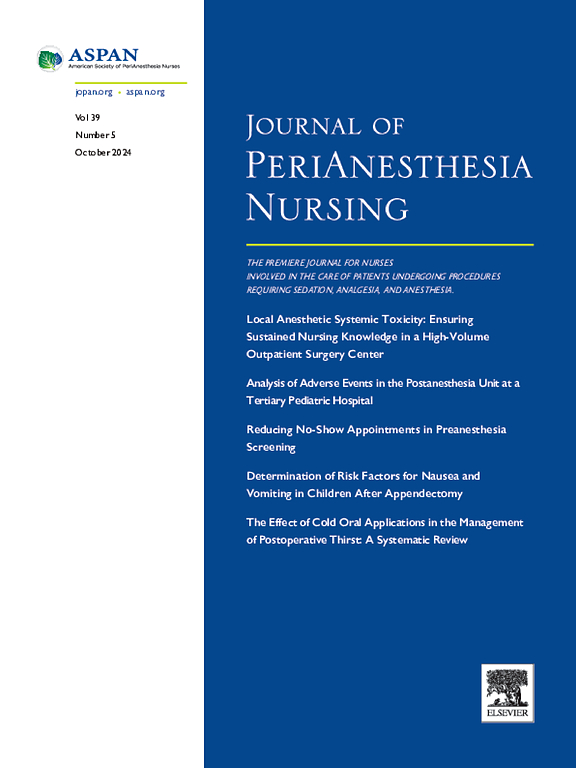Effects of Sevoflurane and Propofol During Mechanical Ventilation: A Meta-analysis of Randomized Controlled Trials
IF 2
4区 医学
Q2 NURSING
引用次数: 0
Abstract
Purpose
To compare the inflammatory response, hemodynamic stability, and postoperative recovery of sevoflurane versus propofol after mechanical ventilation during surgery, to provide references for rational anesthesia utility in clinical practice by meta-analysis.
Design
Systematic review and meta-analysis.
Methods
Pubmed, Web of Science, Cochrane Library, Wanfang Data, China National Knowledge Infrastructure, and Chinese BioMedical Literature Database were searched by computer for trials on the anesthetic effects of sevoflurane and propofol after mechanical ventilation during surgery. A random- or fixed-effects model was applied to analyze the clinical indicators and adverse impact based on heterogeneity.
Findings
As of April 21, 2023, 912 articles were retrieved, and 36 eligible articles were finally identified after screening, covering 2,691 surgical patients for meta-analysis. The combined results exhibited that the level of tumor necrosis factor (TNF)-α in alveolar lavage was significantly different between the 2 groups (−0.94, 95% confidence interval [CI]: −1.82 to −0.05, P = .038). Compared with sevoflurane, propofol significantly increased TNF-α levels in alveolar lavage. In plasma or serum, propofol significantly increased the levels of interleukin-10 (−0.73, 95% CI: −1.36 to −0.10, P = .023) and TNF-α (−0.65, 95% CI: −1.21 to −0.09, P = .022).
Conclusions
At alveolar lavage and serum or plasma levels of inflammatory factors, the proinflammatory factor TNF-α was significantly lower in the sevoflurane group than in the propofol group. This indicates that sevoflurane has a certain role in alleviating local and systemic lung inflammation. However, more randomized controlled studies are warranted in the future to confirm whether there is a difference in hemodynamic stability and postoperative recovery of patients.
七氟醚和异丙酚在机械通气中的作用:随机对照试验的荟萃分析。
目的:通过meta分析比较手术中机械通气后七氟醚与异丙酚的炎症反应、血流动力学稳定性及术后恢复情况,为临床合理使用麻醉提供参考。设计:系统回顾和荟萃分析。方法:计算机检索Pubmed、Web of Science、Cochrane Library、万方数据、中国国家知识基础设施和中国生物医学文献数据库,检索七氟醚和异丙酚在手术中机械通气后麻醉效果的试验。基于异质性,采用随机效应或固定效应模型分析临床指标和不良影响。结果:截至2023年4月21日,检索到912篇文章,筛选后最终确定36篇符合条件的文章,涵盖2691例手术患者进行meta分析。综合结果显示,两组大鼠肺泡灌洗液中肿瘤坏死因子(TNF)-α水平差异有统计学意义(-0.94,95%可信区间[CI]: -1.82 ~ -0.05, P = 0.038)。与七氟醚相比,异丙酚可显著提高肺泡灌洗液中TNF-α水平。在血浆或血清中,异丙酚显著增加白细胞介素-10 (-0.73,95% CI: -1.36 ~ -0.10, P = 0.023)和肿瘤坏死因子-α (-0.65, 95% CI: -1.21 ~ -0.09, P = 0.022)的水平。结论:在肺泡灌洗及血清、血浆炎症因子水平上,七氟醚组促炎因子TNF-α明显低于异丙酚组。说明七氟醚对减轻局部和全身肺部炎症有一定的作用。然而,未来需要更多的随机对照研究来证实在血流动力学稳定性和患者术后恢复方面是否存在差异。
本文章由计算机程序翻译,如有差异,请以英文原文为准。
求助全文
约1分钟内获得全文
求助全文
来源期刊

Journal of Perianesthesia Nursing
NURSING-
CiteScore
2.20
自引率
17.60%
发文量
279
审稿时长
90 days
期刊介绍:
The Journal of PeriAnesthesia Nursing provides original, peer-reviewed research for a primary audience that includes nurses in perianesthesia settings, including ambulatory surgery, preadmission testing, postanesthesia care (Phases I and II), extended observation, and pain management. The Journal provides a forum for sharing professional knowledge and experience relating to management, ethics, legislation, research, and other aspects of perianesthesia nursing.
 求助内容:
求助内容: 应助结果提醒方式:
应助结果提醒方式:


